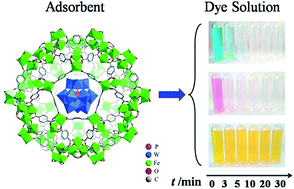Encapsulation of tungstophosphoric acid into harmless MIL-101(Fe) for effectively removing cationic dye from aqueous solution†
Abstract
A Keggin-type polyoxometalate H3PW12O40 (PW12) was firstly incorporated into the harmless porous metal organic framework MIL-101(Fe) resulting in POM@MOF composite material (denoted as PW12@MIL-101). The material was synthesized by a one-pot solvothermal reaction of H3PW12O40, FeCl3·6H2O and terephthalic acid (H2bdc). The composite was characterized by FTIR, XRD, thermogravimetric analysis (TGA), inductively coupled plasma (ICP) spectrometry, SEM, EDS, 31P NMR and nitrogen adsorption–desorption isotherms. These results demonstrated the successful insertion of H3PW12O40 within the cavities of MIL-101(Fe). The adsorption rate of the isolated MIL-101 was up to 30.7% and 28.3% for cationic dyes methylene blue (MB) and rhodamine B (RhB), and 82% for anionic dye methyl orange (MO) within 30 min. However, the dye adsorption capacity of MIL-101 has greatly changed by introducing highly electronegative polyoxoanions into the cages of MIL-101. The adsorption rate of PW12@MIL-101 composite was able to reach 99% and 96% for cationic dyes MB and RhB, and 16% for anionic dye MO in the initial 5 min. Surprisingly, the composite not only exhibited a large-scale adsorption capacity of 473.7 mg g−1 for MB, but also could quickly remove 97.3% MB from the dye solution with 1 ppm (1 mg L−1). Furthermore, this material could be easily desorbed for reuse, and the structure of the composite was intact during the adsorption experiment. Thus, it is a promising and environmentally friendly adsorbent for removing cationic organic pollutants in dye-wastewater.


 Please wait while we load your content...
Please wait while we load your content...